November 1st, 2018 by IISG
The Lake Michigan Sea Grant programs, including Wisconsin Sea Grant, Michigan Sea Grant and Illinois-Indiana Sea Grant, seek integrated proposals to better understand coastal hydrodynamics and nearshore sediment transport processes on Lake Michigan, to help effectively communicate this information to promote sustainable shore protection, and to increase the integrity of beaches and stabilize bluffs. The result would be more resilient coastal communities and economies.
Research is to be conducted in the 2020–22 biennium. Up to $100,000 per year for two years will be available for funding each of the Michigan, Wisconsin, and Illinois-Indiana portions of a joint research project (i.e., up to $300,000 per year total). Michigan and Illinois- or Indiana-based partners must demonstrate a 50 percent match (1 non-federal dollar for every 2 dollars requested). Match is not required for Wisconsin partners.
By partnering, the three Lake Michigan Sea Grant programs can support broader-scale projects to tackle challenges at a regional scale. In addition, generating collaborations across state lines can enrich the expertise of our in-state research teams.
Pre-proposals must demonstrate plans for collaboration between researchers from two (2) or three (3) of the state programs. The amount of funding available to the research team depends on the number and nature of collaborating partners; e.g., a researcher from Michigan and a researcher from Wisconsin could submit a proposal together for up to $400,000; researchers from Michigan, Wisconsin, and Illinois could submit a proposal together for up to $600,000.
More Information
Deadline
- Pre-proposals are due by 3pm CST (4pm EST) Friday, January 11, 2019.
Questions
For more information, Illinois and Indiana partners can contact Illinois-Indiana Sea Grant Research Coordinator Carolyn Foley (cfoley@purdue.edu).
If you have interest in this topic and/or skills that would be relevant to a research team but you are not sure who to connect with in other states, contact Carolyn Foley (cfoley@purdue.edu), who can provide a Google doc link that is a resource for researchers who may be interested in partnering. Listing your information in this Google doc is not a requirement for submission to this RFP. It simply serves to help researchers find relevant partners.
January 13th, 2017 by IISG
For the month of January, the Sea Grant 50th is focusing on K to Gray education—yes, that includes everyone—and within IISG there is no shortage of resources for all ages.
Terri Hallesy who has been with the IISG education team for 13 years has seen teaching trends change over the years, but in the end, she knows it’s really very simple.
“I just enjoy working with all the dynamic, engaging specialists,” Hallesy says. “They each focus on diverse programs and target different audiences. What’s great is they’re always ready to collaborate using the latest and most relevant educational tools.”
Below we are highlighting five of the projects the education team has produced—in collaboration with specialists, other Sea Grants, as well as educators—that capture that cooperative spirit.
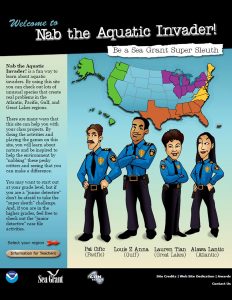 Nab the Aquatic Invader!
Nab the Aquatic Invader!
Launched in 2009, this website focuses on the suspects–aka the invasive species–in four regions of the country: Atlantic, Pacific, Gulf, and Great Lakes. In each region, visitors can see read interrogation interviews with the 10 Most Wanted AIS and learn their origin, problems they cause, and some control methods used to slow the spread of these species. The project was featured in the Smithsonian in 2010.
Collaborators included New York, Michigan, Wisconsin, Pennsylvania, and Ohio Sea Grants.
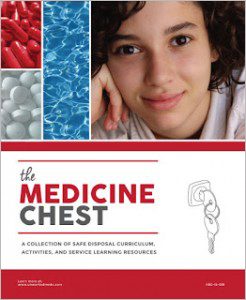 The Medicine Chest
The Medicine Chest
Illinois-Indiana Sea Grant’s (IISG), The Medicine Chest, invites high school students to metaphorically open up those doors and investigate what makes those chemicals harmful to people, pets, and the environment when improperly disposed. The curriculum was updated last year.
Collaborators included Pennsylvania Sea Grant, U.S. EPA Great Lakes National Program Office, and Paul Ritter and Eric Bohm, P2D2 Program Administrators.
Sensible Disposal of Unwanted Medicines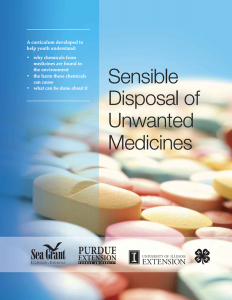
When medications are flushed down the toilet, wastewater treatment plants can’t always filter out the harmful chemicals that can affect wildlife and even get into drinking water supplies. This 4-H guidebook and curriculum, designed for informal education audiences, provides five inquiry-based lessons to help high school youth understand the harmful effects of improper disposal of medicines and what they can do to help.
Collaborators included 4-H and Penn High School, Mishawaka, Indiana.
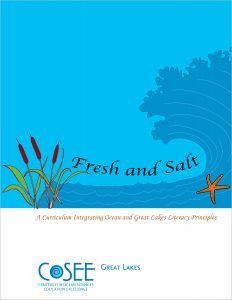 Fresh and Salt
Fresh and Salt
Fresh and Salt is a collection of activities that enhance teacher capabilities to connect Great Lakes and ocean science topics. Designed to be used by teachers in grades 5-10, this curriculum provides an interdisciplinary approach to ensure that students achieve optimum science understanding of both Great Lakes and Ocean Literacy Principles.
Collaborators included Centers for Ocean Science Education Excellence and Ashland University.
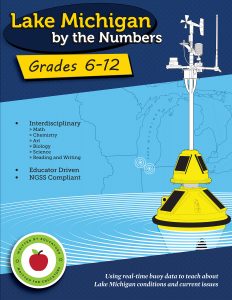 Lake Michigan by the Numbers
Lake Michigan by the Numbers
This curriculum was created by teachers who attended a day-long workshop to learn how to incorporate buoy data into their classroom instruction. They created these data-rich, STEM-based lesson plans that boost understanding of Great Lakes issues by incorporating real-time data from Great Lakes buoys.
Collaborators included Indiana Department of Natural Resources, Lake Michigan Coastal Program, and Center for Great Lakes Literacy.
Illinois-Indiana Sea Grant is a part of University of Illinois Extension and Purdue Extension.
October 17th, 2016 by IISG
The National Sea Grant Program is celebrating its 50th anniversary this year and Illinois-Indiana Sea Grant (IISG) is looking back at its own origins through the eyes of its first leader.
In 1982, IISG had its modest beginnings as a small marine extension project, through a partnership of the University of Illinois, Purdue University, and the National Oceanic and Atmospheric Administration.
Robert Espeseth was at the helm from 1982 through 1994. Now a retired University of Illinois professor of leisure studies, he recalled those early years as both part happenstance and part destiny.
Like a star football quarterback recalling his glory days, he shared the play-by-play of the creation of IISG.
“Jim Peterson, who had a joint appointment with Purdue and Indiana, and I were up there at a Great Lakes regional workshop for recreation specialists in 1980,” Espeseth recalled. “And one of the fellows from Michigan was getting funding out of Michigan Sea Grant, and he said, ‘Have you guys ever looked into that?’ And we said, ‘What is it?’ And he said, ‘With Illinois and Indiana not being in the program they’re anxious to complete the Great Lakes for programs covering all the shoreline.’”
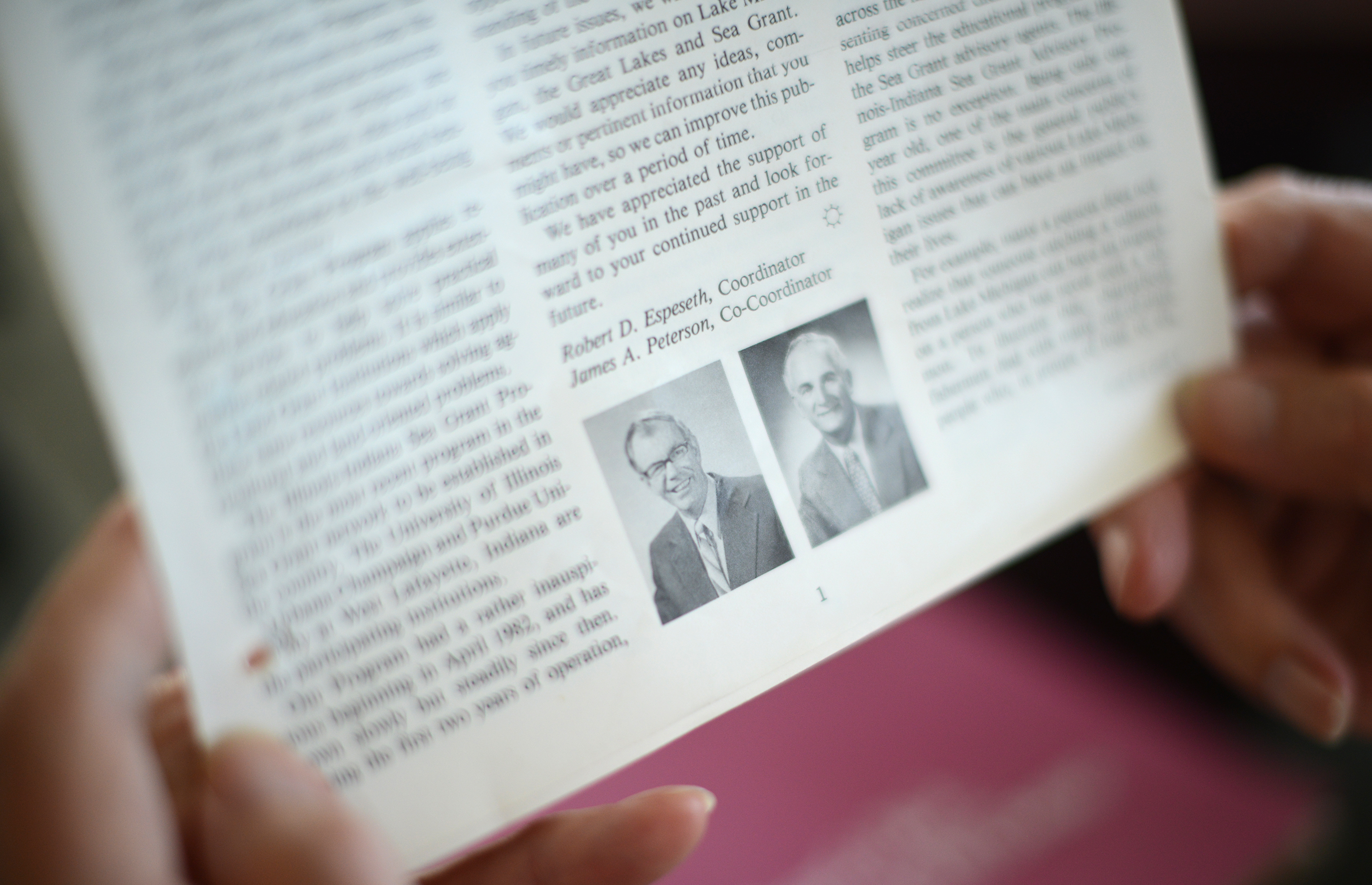
And with that exchange, the pursuit to “cover the shoreline” began.
Peterson and Espeseth were both going to be in Washington, so they decided to pay a visit the National Sea Grant Office in Silver Spring, Maryland.
They arrived without an appointment, but Espeseth wasn’t going to leave without meeting the director, and he had the perfect in.
It just so happened that the National Sea Grant Program director, the late Ned Ostenso, was a coxswain in the boat Espeseth rowed during his days at the University of Wisconsin.
“’He’s really busy, he wouldn’t have time,’” Espeseth recalled being told.
“I said, ‘Just call him and tell him Bob Espeseth is here.’ So he did and Ned said, ‘Bring him on up!’”
Ostesno encouraged Espeseth and Peterson and explained how anxious he was to get Illinois and Indiana onboard, but he warned that it would be a long process.
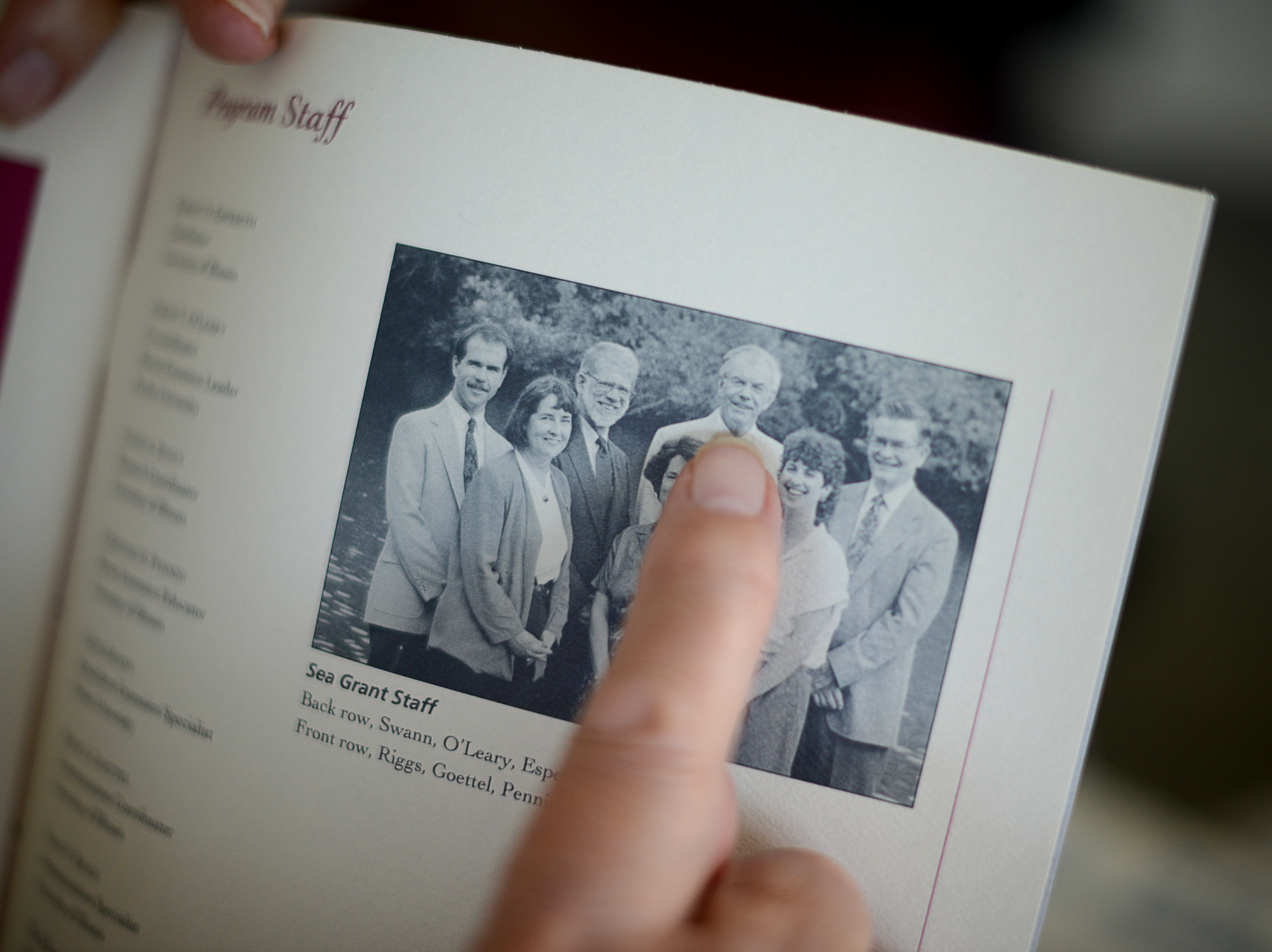
How right he was.
Their first application in 1981 was turned down for not having a strong research component and because the two universities, Purdue and Illinois, weren’t very supportive of the Sea Grant mission. It wasn’t until 1982 that IISG finally got approved as a marine extension project.
Yet, there was still some uncertainty about the focus and direction of the program.
Initially the emphasis was on aquaculture, recreation and shoreline tourism—topics that were not as popular with other Sea Grants. IISG really took off once it added more research-focused areas like invasive species, water quality and pollutants.
The outreach staff grew from a single specialist to a team of over 20, located at universities and agencies in the two states. In 1997, IISG was awarded College Program status by the U.S. Department of Commerce.
Espeseth smiled as he thought back to those early days.
“I just talked to Jim Peterson the other day and he said laughing, ‘Yeah, that was really a shot in the dark!’ But at the behest of our compatriot up there in Michigan, that’s how it got started.”
February 29th, 2016 by IISG
There are reefs in the Great Lakes?
That was my first thought when I sat down to interview for a field technician position in the fall of 2014. I had been working at a tech job at Purdue University, but I felt that it was time for a change–to something that was a bit more interesting to me. When I had the chance to interview to be a field tech on a fish ecology project, I knew that the time for change had arrived. But working on reefs? Coral, colorful, vibrant reefs teeming with a spectacular array of exotic fish species? I asked the post-doctoral fellow conducting my interview, Dr. Mitchell Zischke, if those were the kind of reefs he was talking about.
“Not quite,” said Mitch. “Reefs in the Great Lakes are rocky, made of cobble, gravel, and other stony fragments.” Ah. That’s very different than the vision most people get when they think of underwater reefs. A lot of publicity is directed towards oceanic coral reefs and their current plight worldwide, and rightly so. But I think sometimes that comes at the expense of exposure to unique and threatened environments much closer to home. The reef systems of the Great Lakes are a prime example.
I say this based on my own experiences as a native of the Great Lakes region. I grew up in a small town in western Michigan, right on the shores of Lake Michigan. My family often traveled around the state, spending time at all of the Great Lakes. Yet I never heard mention of any rocky reefs. I’d wager that outside of die-hard fishermen, most citizens of the region haven’t been exposed to our local reefs, either. Going forward, I’m hopeful that a lot of exciting research on the Great Lakes is about to change that fact.
That’s how my current project fits into all of this. It turns out that I liked being a fisheries ecology technician enough that it led directly into graduate school at Purdue University. I am now a Master’s student under the guidance of Dr. Tomas Höök, associate professor at Purdue and associate director of research for Illinois-Indiana Sea Grant. Along with many other organizational partners (including Michigan Sea Grant, Michigan Department of Natural Resources, Michigan Department of Environmental Quality, U.S. Fish and Wildlife Service, and the United States Geological Survey, to name a few) we are in the beginning stages of potential rocky reef restoration in Saginaw Bay in Lake Huron.
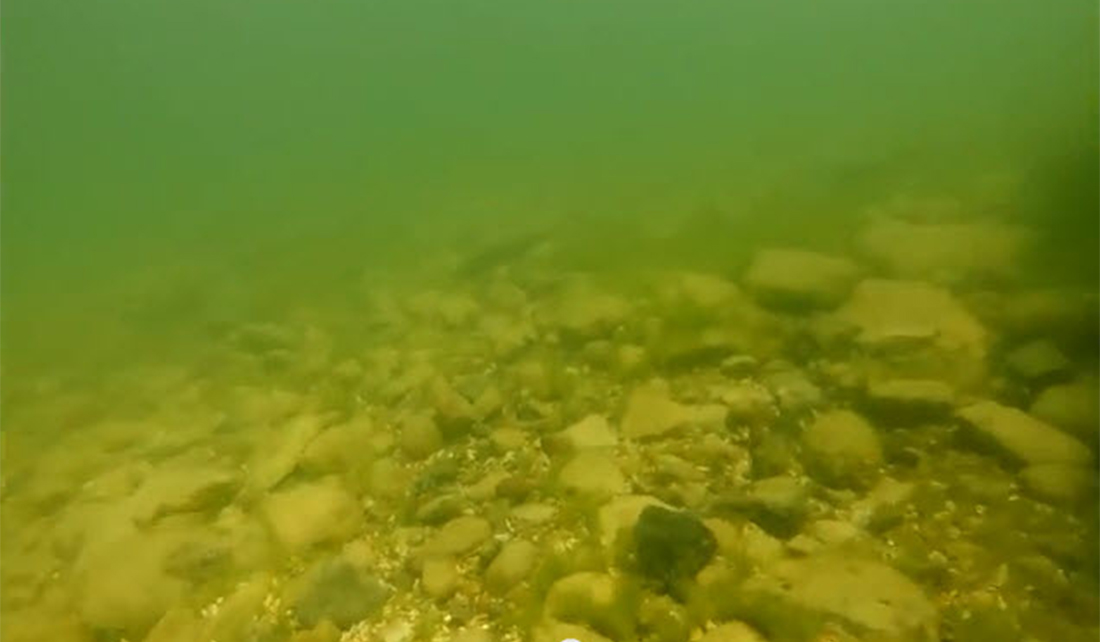
To understand why reef restoration in Saginaw Bay is a good idea, a little historical background is important. Years ago, Saginaw Bay was the second largest walleye fishery in all the Great Lakes, and had a healthy population of fish spawning on rocky reefs in the bay. These reefs provided many benefits to incubating eggs, including excellent protection from predators. Long-term sedimentation and poor land use led to most of those reefs being lost. This had profound negative impacts on walleye, as well as on other recreationally- and commercially-important fish species. Today, the walleye population has recovered, but the fish spawns almost completely in tributary rivers that feed into Saginaw Bay, rather than the bay itself. Reef restoration would allow walleye to have prime spawning habitat in the bay once more, and hopefully encourage these fish to resume using some of their historic spawning grounds. Beyond the obvious benefits to an increased amount of spawning area, this would also pave the way for a more geographically- and genetically-diverse walleye population. Such diversity could prove very important during times of stress. Of course, many other fish species, such as lake whitefish, would also be able to use restored reefs.
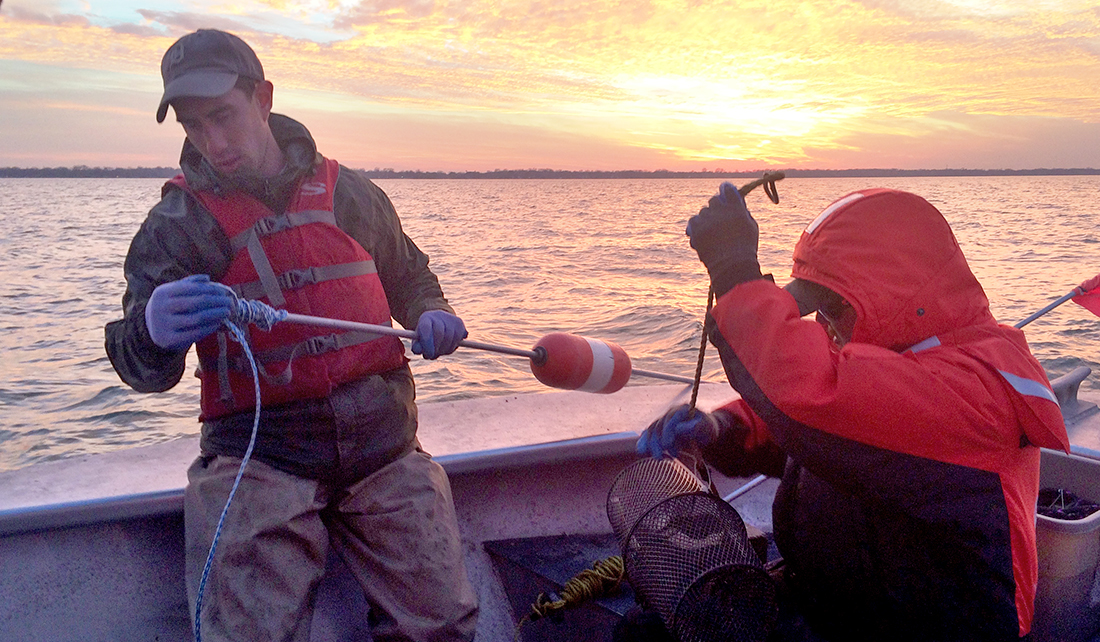
However, before rocky reef habitat could be restored in Saginaw Bay, we needed to make sure that restoration would have a good chance of being successful. Restoration projects are never cheap, and we wanted to be sure that funding was being wisely spent. That’s where my specific project comes in. A small field crew, comprising members of Purdue University (including me, Dr. Zischke, and Jay Beugly, who also serves as an aquatic ecology specialist for Illinois-Indiana Sea Grant) and the USGS, was tasked with assessing current spawning patterns within Saginaw Bay. Essentially, we wanted to see what currently degraded reef sites looked like, whether key species like walleye and lake whitefish were spawning near those degraded sites, whether they were depositing eggs, and whether predators were around to eat those eggs. If we could say that water quality was decent, target species were spawning in the area and depositing eggs, and that egg predators weren’t too abundant, we might have a reasonable shot at successful reef restoration.
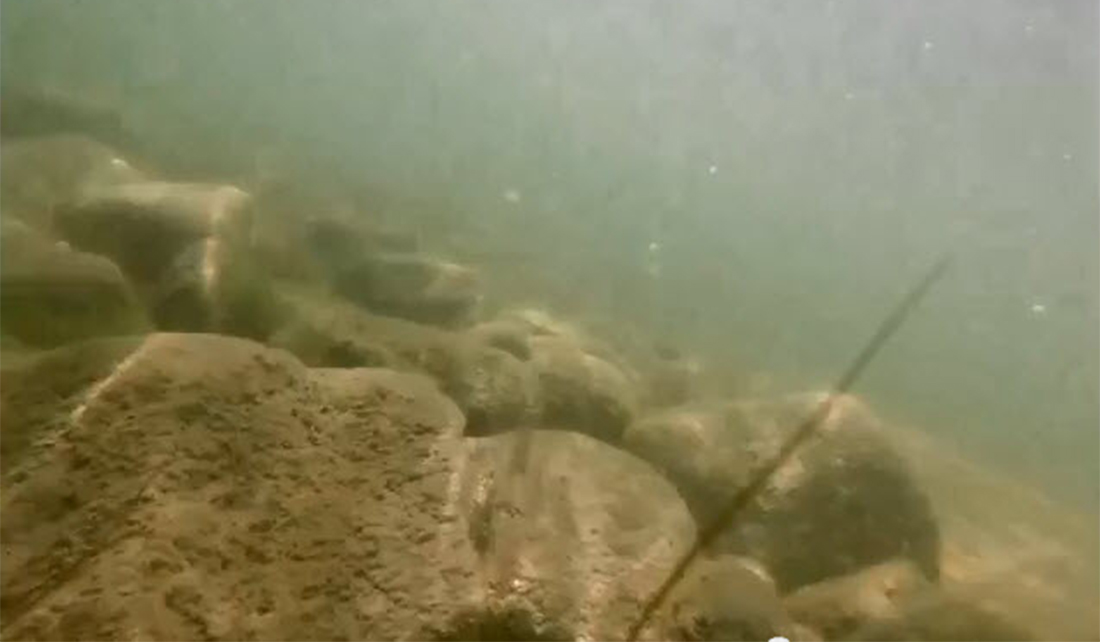
We’ve been at it since late 2014, and though results are still preliminary, there are some positive signs. Water quality is good, and some sites look receptive to adding additional reef structure. Spawning walleye and lake whitefish are being found across the bay, and they’re depositing eggs, too. Numbers of fish and eggs are low, but the fact that fish exist to take advantage of potentially restored reefs is hugely important. We’ve also found that egg predators are present, but that the biggest predation risk is probably from large-bodied fish like common carp and catfish. Given these findings, we are optimistic that rocky reef restoration can be successful in Saginaw Bay. Hopefully, restored reefs will attract higher numbers of fish to spawn, while simultaneously providing cracks and crevices to help eggs avoid large egg predators.
If everything goes right, reef restoration in Saginaw Bay could be going on long after I’ve left Purdue. Really, I think that’s one of the coolest things about this project: It has so much potential. With many groups involved, like Sea Grant, and tons of habitat to restore, reef restoration could be the definition of a long-term undertaking. Who knows, maybe I’ll find myself back on the familiar shores of Saginaw Bay one day, working once more on a project that helped launch what I hope will be a long career in fisheries science. For now, I’m just focused on the upcoming field season. It’s the last chunk of field work in our spawning assessment. If we keep finding some of the same patterns, I’m very excited for the future of reef restoration in Saginaw Bay and across the Great Lakes.
November 11th, 2014 by iisg_superadmin
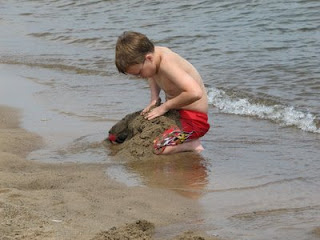 If you’re a regular visitor to Great Lakes beaches, you likely noticed that this year’s swim season was chillier than normal. Cold enough, in fact, that many chose to skip swimming in favor of other beach activities. And according to officials at the National Weather Service, this may explain the unusually low number of current-related fatalities and rescues this year.
If you’re a regular visitor to Great Lakes beaches, you likely noticed that this year’s swim season was chillier than normal. Cold enough, in fact, that many chose to skip swimming in favor of other beach activities. And according to officials at the National Weather Service, this may explain the unusually low number of current-related fatalities and rescues this year.
From Michigan Sea Grant:
There were 6 fatalities and 12 rescues related to currents on the Great Lakes, which is below the 12-year average of 12 fatalities and 25 rescues per year.
As is typical, the majority of the 2014 incidents occurred along Lake Michigan. On average from 2002-2014, Lake Michigan had 25 incidents per year, while Lake Erie had 5 incidents per year, Lake Superior had 3 incidents and Huron and Ontario average 1 to 1.5 per year, respectively.
The data for 2014 has now been updated in the Great Lakes Current Incident Database, available at DangerousCurrents.org. The database was developed and is maintained by Michigan Sea Grant and National Weather Service (NWS). Megan Dodson, a NWS meteorologist, gathers the statistics for the database and provides yearly swim season assessments of conditions related to currents.
Dodson noted the cool weather influenced not just the below-average number of incidents, but where they happened too.
“A majority of the current-related incidents in 2014 occurred near river mouths, which is unusual when compared with past years,” she said. “The cooler air and water temperatures may have driven beachgoers to swim near river mouths and other outlets, where the water is much warmer. However, there are currents present that can be strong and vary depending on the flow of the outlet and the waves at the beach. While these currents are most dangerous during times of high waves, they can still be strong despite calmer lake conditions — as we saw during the 2014 swim season.” Read more
Swim season may be over, but it is never too early to start planning for next year. To stay safe in the water, be sure to:
- Steer clear of the pier — Nearly 60 percent of fatalities and rescues in the Great Lakes database occurred near breakwaters and piers. Structural currents are nearly always present near these barriers, even when waves are low. Breaking waves can also bounce off the structure, making swimming nearly impossible.
- Stay dry when waves are high — Nearly 85 percent of fatalities and rescues in the Great Lakes database happened when waves are 3-5 feet or greater. Unlike in the oceans, Great Lakes waves crash against the shoreline in rapid succession, making it difficult to swim. Additionally, strong rip currents are more likely when waves are above 3 feet. The combination of quickly approaching waves and strong currents create extremely dangerous conditions for swimmers.
- Don’t swim in the outlet — Water flowing from a river mouth or other outlet can push swimmers out into the lake. Nearly 40 percent of the 2014 incidents were outlet-current related.
June 16th, 2014 by iisg_superadmin
It’s beach season once again in southern Lake Michigan, and the rip current warnings have already begun.
The National Weather Service (NWS) has issued at least one advisory since Illinois and Indiana beaches opened last month asking beach-goers to think twice before taking a dip in the lake. And for good reason. Rip currents and other dangerous currents are the biggest threat to Great Lakes swimmers. Roughly 140 people have drowned in the lakes over the last 12 years due at least in part to dangerous currents. And most of those incidents happened in Lake Michigan.
Illinois-Indiana Sea Grant hopes to bring these numbers down with a new outreach effort that will raise awareness about dangerous currents in the Great Lakes. The “Implementing Dangerous Currents Best Practices” project was recently awarded funding from the NOAA Coastal Storms Program.
A collaborative effort Sea Grant programs in Michigan and Wisconsin, the project will include print and online resources—including educational videos—that introduce the science behind rip currents, provide tips for avoiding them, and explain what to do if you or others are caught in one. Many of these resources will be available in both English and Spanish.
Watch for further information on these outreach efforts and rip currents in the coming months. In the meantime, you can find tips for staying safe at the beach this summer at dangerouscurrents.org.
“Implementing Dangerous Currents Best Practices” continues years of efforts by Great Lakes Sea Grant programs, NOAA, and NWS to reduce dangerous currents drownings across the region. To learn more about these efforts, visit Rip Current Safety.
March 17th, 2014 by iisg_superadmin
Research into the Lake Michigan food web has increased in the last decade, but there are still a lot of questions—exactly what is eating what, and how is that dynamic affected by environmental changes? To find answers to these and other questions, researchers from federal and state agencies, universities, and non-profit organizations will come together next month in Ann Arbor, MI. The two-day meeting will feature discussions on past and current food web studies and end with a plan for future research.

The meeting kicks off April 1 with presentations on several Sea Grant- and EPA-funded studies. IISG’s Tomas Hook, Sergiusz Czesny, director of the Lake Michigan Biological Station, and Bo Bunnell of the USGS Great Lakes Science Center will discuss the state of Lake Michigan fish populations, including the results of a three-year investigation of the differences in nearshore food webs across the lake. Harvey Bootsma, a researcher at the University of Wisconsin-Milwaukee, and NOAA’s Henry A. Vanderploeg will also be onsite to talk about recent findings on the diets of phytoplankton, algae, and other species at the bottom of the food chain. Additional presentations, orchestrated by IISG’s Paris Collingsworth and featuring IISG-funded scientist Cary Troy, will talk about research on the physical dynamics of the lake and steady flow of nutrients brought in by stormwater runoff—two important factors affecting food web structures. Paris will also introduce plans for upcoming monitoring and field activities in Lake Michigan as part of the Cooperative Science and Monitoring Initiative.
Conversations on the second day will turn to planning. IISG research staff will team up with representatives from the Wisconsin and Michigan Sea Grant programs to lead discussions on data still needed to understand how invasive species, contaminants, climate change, and other factors are affecting the Lake Michigan food web. Meeting attendees will also have an opportunity to briefly talk about their research and where they hope to go next. The gaps and next steps identified will help Lake Michigan Sea Grant programs identify research projects to fund in the coming years.
This meeting is the third of its kind since 2008. And, like those before it, this year’s meeting is coordinated by IISG and GLRRIN Lake Michigan partners from Wisconsin Sea Grant, Michigan Sea Grant, the NOAA Great Lakes Environmental Research Laboratory, the US EPA Great Lakes National Program Office, and the USGS Great Lakes Science Center. Previous meetings helped launch the 2010 Lake Michigan Intensive Monitoring Field Year and resulted in roughly $1.7 million in funding for food web projects.
To learn more about the meeting and how to attend, contact Carolyn Foley. And stay tuned for instructions on how to stream this meeting in real time.













